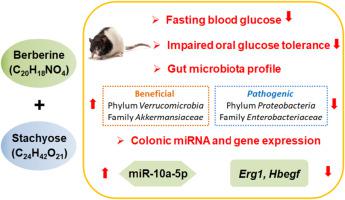Our official English website, www.x-mol.net, welcomes your
feedback! (Note: you will need to create a separate account there.)
Berberine combined with stachyose improves glycometabolism and gut microbiota through regulating colonic microRNA and gene expression in diabetic rats
Life Sciences ( IF 5.2 ) Pub Date : 2021-09-01 , DOI: 10.1016/j.lfs.2021.119928 Caina Li 1 , Hui Cao 1 , Yi Huan 1 , Wenming Ji 1 , Shuainan Liu 1 , Sujuan Sun 1 , Quan Liu 1 , Lei Lei 1 , Minzhi Liu 1 , Xuefeng Gao 1 , Yaxin Fu 1 , Pingping Li 1 , Zhufang Shen 1
Life Sciences ( IF 5.2 ) Pub Date : 2021-09-01 , DOI: 10.1016/j.lfs.2021.119928 Caina Li 1 , Hui Cao 1 , Yi Huan 1 , Wenming Ji 1 , Shuainan Liu 1 , Sujuan Sun 1 , Quan Liu 1 , Lei Lei 1 , Minzhi Liu 1 , Xuefeng Gao 1 , Yaxin Fu 1 , Pingping Li 1 , Zhufang Shen 1
Affiliation

|
Berberine is effective for type 2 diabetes mellitus (T2DM), but has limited use in clinic. This study aims to evaluate the effect of berberine combined with stachyose on glycolipid metabolism and gut microbiota and to explore the underlying mechanisms in diabetic rats. Zucker diabetic fatty (ZDF) rats were orally administered berberine, stachyose and berberine combined with stachyose once daily for 69 days. The oral glucose tolerance and levels of blood glucose, insulin, triglyceride and total cholesterol were determined. The gut microbial profile, colonic miRNA and gene expression were assayed using Illumina sequencing. The quantitative polymerase chain reaction was used to verify the expression of differentially expressed miRNAs and genes. Repeated treatments with berberine alone and combined with stachyose significantly reduced the blood glucose, improved the impaired glucose tolerance, and increased the abundance of beneficial , decreased that of pathogenic in ZDF rats. Furthermore, combined treatment remarkably decreased the abundances of and in comparison to berberine. Combined treatment evidently decreased the expression of intestinal early growth response protein 1 () and heparin-binding EGF-like growth factor (), and significantly increased the expression of miR-10a-5p, but berberine alone not. Berberine combined with stachyose significantly improved glucose metabolism and reshaped gut microbiota in ZDF rats, especially decreased the abundance of pathogenic and compared to berberine alone, providing a novel strategy for treating T2DM. The underlying mechanisms may be associated with regulating the expression of intestinal , and miR-10a-5p, but remains further elucidation.
中文翻译:

小檗碱联合水苏糖通过调节糖尿病大鼠结肠 microRNA 和基因表达改善糖代谢和肠道微生物群
小檗碱对2型糖尿病(T2DM)有效,但在临床上的应用有限。本研究旨在评估小檗碱联合水苏糖对糖尿病大鼠糖脂代谢和肠道菌群的影响,并探讨其潜在机制。 Zucker糖尿病肥胖(ZDF)大鼠每天口服一次小檗碱、水苏糖和小檗碱联合水苏糖,持续69天。测定口服葡萄糖耐量以及血糖、胰岛素、甘油三酯和总胆固醇的水平。使用 Illumina 测序分析肠道微生物谱、结肠 miRNA 和基因表达。采用定量聚合酶链反应验证差异表达的miRNA和基因的表达。单独使用小檗碱和联合水苏糖反复治疗可显着降低ZDF大鼠的血糖,改善糖耐量受损,增加有益菌丰度,减少致病菌丰度。此外,与小檗碱相比,联合治疗显着降低了小檗碱的丰度。联合治疗明显降低肠道早期生长反应蛋白 1 () 和肝素结合 EGF 样生长因子 () 的表达,并显着增加 miR-10a-5p 的表达,但单独使用小檗碱则不然。与单独使用小檗碱相比,小檗碱联合水苏糖显着改善了 ZDF 大鼠的葡萄糖代谢并重塑了肠道微生物群,尤其是降低了致病菌的丰度,为治疗 T2DM 提供了新的策略。其潜在机制可能与调节肠道 和 miR-10a-5p 的表达有关,但仍有待进一步阐明。
更新日期:2021-09-01
中文翻译:

小檗碱联合水苏糖通过调节糖尿病大鼠结肠 microRNA 和基因表达改善糖代谢和肠道微生物群
小檗碱对2型糖尿病(T2DM)有效,但在临床上的应用有限。本研究旨在评估小檗碱联合水苏糖对糖尿病大鼠糖脂代谢和肠道菌群的影响,并探讨其潜在机制。 Zucker糖尿病肥胖(ZDF)大鼠每天口服一次小檗碱、水苏糖和小檗碱联合水苏糖,持续69天。测定口服葡萄糖耐量以及血糖、胰岛素、甘油三酯和总胆固醇的水平。使用 Illumina 测序分析肠道微生物谱、结肠 miRNA 和基因表达。采用定量聚合酶链反应验证差异表达的miRNA和基因的表达。单独使用小檗碱和联合水苏糖反复治疗可显着降低ZDF大鼠的血糖,改善糖耐量受损,增加有益菌丰度,减少致病菌丰度。此外,与小檗碱相比,联合治疗显着降低了小檗碱的丰度。联合治疗明显降低肠道早期生长反应蛋白 1 () 和肝素结合 EGF 样生长因子 () 的表达,并显着增加 miR-10a-5p 的表达,但单独使用小檗碱则不然。与单独使用小檗碱相比,小檗碱联合水苏糖显着改善了 ZDF 大鼠的葡萄糖代谢并重塑了肠道微生物群,尤其是降低了致病菌的丰度,为治疗 T2DM 提供了新的策略。其潜在机制可能与调节肠道 和 miR-10a-5p 的表达有关,但仍有待进一步阐明。











































 京公网安备 11010802027423号
京公网安备 11010802027423号